|
|
Post by codystarbuck on Mar 22, 2017 21:56:23 GMT -5
I decided to do this as a companion to my other thread, covering independent comics, The Other Guys, Non-DC and Marvel Reviews. Miracleman is a book I want to discuss issue by issue, as each one is just superb. It's a series that captured interest from the start and was a prestige book for Eclipse, though often a frustrating experience for readers, as we waited for the next installment. After Alan Moore finished we got Neil Gaiman's take and waited longer, as Eclipse's financial woes held things up (not to mention Neil's growing fame). Eclipse went under, leaving the Silver Age unfinished and we waited for something to happen, as the book was trapped in courts. Marvel ended up with the title and we are still waiting for the remainder of the Silver Age and the beginning of the Dark Age. Miracleman began life as Marvelman, in the UK. The publisher, L. Miller & Sons was reprinting black & white stories from Fawcett's Captain Marvel series. When Fawcett settled their battle with DC and ceased publishing the comic, in 1953, Miller was left without one of it's best sellers. They turned to Mick Anglo, who created a British version of the Big Red Cheese and his family. Captain Marvel became Marvelman, Mary Marvel was replaced by Young Marvelman (no icky girls here!), CM Jr by Kid Marvelman. Billy Batson became Mickey Moran, Shazam was replaced by scientist Guntag Borghelm, Sivanna by Dr Gargunza and the magic word SHAZAM by KIMOTA. Kids ate it up, until 1963, when the series ended. In 1982, Dez Skinn brought the character back in the debut issue of Warrior magazine.      He tapped an up and coming writer to script it: Alan Moore. Working with moore was artist Gary Leach. Leach eventually left the book and Alan Davis came onboard. Then, it came to an abrupt end. Marvel threatened Skinn over the use of the Marvel name; specifically, the Marvelman Special, which was published separately (with reprints of the Anglo material). Marvel didn't have a case; but, they had deep pockets and Skinn knew it. He backed down; but, that wasn't the end of it. Eclipse made a deal with Skinn to reprint Laser Eraser & Pressbutton , a feature in Warrior, and Marvelman, now called Miracleman. Marvel couldn't claim conflict over the name.  Issue one starts things off, as we see Miracleman, in 1956, battle an invader from the future, who uses advanced technology and a knowledge of history to conquer the earth. However, their history must have been a bit murky, as the meet the Miracleman family and have no idea who they are and are soundly defeated. They are sent back to their future of 1981. This takes us into the 'real" 1981, where journalist Mickey Moran is having a nightmare, where he is flying, along with two boys and encounters something strange and horrifying. He has snippets of memory and awakes with a migraine. However, he needs to work and heads off to an assignment to cover a protest at a nuclear power plant. A group of terrorists take over the plant and take several hostages, including Moran. The stress of the situation makes Mickey's migraine worse and he collapses. He is taken out and glances at a window with the power station's name painted on the reverse side. He sees the word "atomic" written backwards (from his perspective) and it triggers a memory. He says the words "kimota" and there is a blinding flash of light and thunder, and a god stands before the dazed terrorists. The god stops the terrorists with little effort, showing that he is impervious to bullets and flies off into the night. 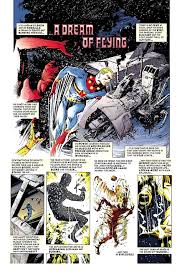  The story continues as Miracleman returns to Mickey's home and speaks to his wife, Liz. At first she is terrified; but, eventually sees the truth in what Miracleman tells her, absurd as it is. He tells her of his past, as Miracleman, based on his memories (which come from the original comics). Liz laughs at the ridiculous nature of the tale, comparing it to a fairytale. He then recounts his last mission, which is his recurring dream. He and his two companions investigated a UFO, when a nuclear blast went off. He awoke in a hospital, with no memory. This part scares Liz, as it sounds more real than the rest. Miracleman describes the horrors that occurred to his companions, as Kid Miracleman is seemingly evaporated and Young Miracleman has his two bodies fused together. The next day, Mickey receives a surprising phone call; it's Johnny bates, the former Kid Miracleman. he is alive and an adult, living in London. Mickey and Liz travel to a reunion, but Liz is uneasy. There is a magnetic power around Johnny. he relates what happened to him and Mickey listens. however, he doesn't buy it. he tells Johnny about the strange feelings he has, about a 16 year-old kid with the power of a god and what that kind of power would do to a young mind like that. he realizes that Johnny survived and grew to adulthood in Kid Miracleman form and has become corrupted by power. Johnny drops the masquerade an unveils his full power and it is greater than Miracleman's! Moore crafts a fantastic story. The opening framing device shows the old Marvelman stories and the sense of whimsy and innocence, a by-product of their birth as a Captain Marvel clone. We see it all as a kid's fantasy. Then, Moore brings you to reality. Mickey Moran is middle-aged and tubby, stuck in a job that isn't going anywhere. He is plagued by vague nightmares of people dying horrible death's and blinding flashes of life. Then the moment comes to him and he remembers the magic word. This is not your average superhero tale. This hero hurt the villains and left them for dead. He tells his story and we laugh at it. He is reunited with his child sidekick, who is a dangerous and psychotic adult. Moore shows that power corrupts and absolute power corrupts, absolutely. He quotes Nietzsche at the beginning and we see Nietzsche's idea of the superman brought to life. Here, gods aren't concerned with mortals, only power. Gary Leach's art is highly detailed and we see the humdrum of everyday life and the wonder of this superbeing. He adds a sparkle effect around Miracleman, which they call the Tinkerbell effect, to show the aura this being has. He captures facial expressions well, adding to the horror. This isn't a superhero tale of adventure; but, a horror tale of tigers who kill because it suits them and they can. It's a chilling idea. To me, this work is far more effective in showcasing "real" superheroes than Watchmen ever was, if they had powers. Dr Manhattan travel's similar territory; but, this works within the realms that we expect of superhero comics and turns them on their head. We want to believe the fantastic story, because we have been taught to. We want to see one of the sidekicks also alive. Moore gives us that, then twists it. With Watchman, you are set up from the beginning to know that the story isn't your usual superhero story. This lulls you into that false hope, then hits you with the reality. |
|
|
|
Post by Spike-X on Mar 22, 2017 23:31:54 GMT -5
I love Marvel/Miracleman. It's still one of my favourite comics ever. I just hope I live long enough to see the story finally completed. Does anyone know what the damn holdup with that is? You'd think four years would have been enough lead time.
(Also, it's Leach, not Leech)
|
|
|
|
Post by tingramretro on Mar 23, 2017 3:23:07 GMT -5
I first discovered Marvelman when I randomly picked up a copy of Warrior #4 (AKA the Warrior Summer Special) in 1982, and it-and the rest of the magazine-made enough of an impression on me that I not only diligently bought every subsequent issue but sent off for the first three as well, quite a commitment for a twelve year old! When Warrior were forced to stop MM's saga mid story I thought we'd never see how it ended, so it was a bit of a godsend when Eclipse picked up the rights in '85, though I still resent the name change to Miracleman. I'm still hoping we'll eventually get the whole story completed, and preferably reprinted in a nice big omnibus, with all the names relettered back to what they should be...
|
|
|
|
Post by codystarbuck on Mar 23, 2017 6:35:10 GMT -5
I love Marvel/Miracleman. It's still one of my favourite comics ever. I just hope I live long enough to see the story finally completed. Does anyone know what the damn holdup with that is? You'd think four years would have been enough lead time. (Also, it's Leach, not Leech) Edited to correct (as well as typos). I double-checked some stuff on Wikipedia; but, a raging cold has dulled my senses. I have two suspicions, as far as Marvel and finishing Gaiman's books. One is that they were talking out their Asgard and didn't have a firm deal set up with Gaiman to continue The Silver Age and write The Dark Age and that they haven't come to an agreement yet; or, that Gaiman's schedule is too heavily loaded, especially with American Gods and he hasn't had the time to devote to it and Marvel basically left it up to him to work in his own time. Either way, it strikes of bad publishing, which is nothing new at DC and Marvel, in recent years. Not that publishing even seems to matter anymore (that's another rant). |
|
|
|
Post by codystarbuck on Mar 23, 2017 6:43:25 GMT -5
I first discovered Marvelman when I randomly picked up a copy of Warrior #4 (AKA the Warrior Summer Special) in 1982, and it-and the rest of the magazine-made enough of an impression on me that I not only diligently bought every subsequent issue but sent off for the first three as well, quite a commitment for a twelve year old! When Warrior were forced to stop MM's saga mid story I thought we'd never see how it ended, so it was a bit of a godsend when Eclipse picked up the rights in '85, though I still resent the name change to Miracleman. I'm still hoping we'll eventually get the whole story completed, and preferably reprinted in a nice big omnibus, with all the names relettered back to what they should be... I first looked at it when Moore and Totleben were working on "Olympus", mainly due to scarcity and access. It was real hard to find in my area and it wasn't until I graduated college that I was able to track down all of the issues and read the whole thing. A couple of years later I found a run of Warrior and bought them up, then found the rest via mail order. I really wish Eclipse had used that Warrior #7 cover; that thing is gorgeous. Late in their life Eclipse put out some t-shirts and I ordered the Miracleman shirt (and the Black Terror one), which was pretty darn cool to walk around in. Warrior was a pretty darn good magazine and I enjoyed most of the features in it. In retrospect, I'm kind of surprised Eclipse didn't leap on V for Vendetta, especially given cat yronwode's politics. I've never seen an account of why that ended up at DC and not Eclipse, especially since they were doing Marvelman and Laser Eraser & Pressbutton. Also kind of sorry we didn't get more Big Ben stories, as I liked the idea of John Steed as a superhero. |
|
|
|
Post by tingramretro on Mar 23, 2017 9:57:24 GMT -5
I first discovered Marvelman when I randomly picked up a copy of Warrior #4 (AKA the Warrior Summer Special) in 1982, and it-and the rest of the magazine-made enough of an impression on me that I not only diligently bought every subsequent issue but sent off for the first three as well, quite a commitment for a twelve year old! When Warrior were forced to stop MM's saga mid story I thought we'd never see how it ended, so it was a bit of a godsend when Eclipse picked up the rights in '85, though I still resent the name change to Miracleman. I'm still hoping we'll eventually get the whole story completed, and preferably reprinted in a nice big omnibus, with all the names relettered back to what they should be... I first looked at it when Moore and Totleben were working on "Olympus", mainly due to scarcity and access. It was real hard to find in my area and it wasn't until I graduated college that I was able to track down all of the issues and read the whole thing. A couple of years later I found a run of Warrior and bought them up, then found the rest via mail order. I really wish Eclipse had used that Warrior #7 cover; that thing is gorgeous. Late in their life Eclipse put out some t-shirts and I ordered the Miracleman shirt (and the Black Terror one), which was pretty darn cool to walk around in. Warrior was a pretty darn good magazine and I enjoyed most of the features in it. In retrospect, I'm kind of surprised Eclipse didn't leap on V for Vendetta, especially given cat yronwode's politics. I've never seen an account of why that ended up at DC and not Eclipse, especially since they were doing Marvelman and Laser Eraser & Pressbutton. Also kind of sorry we didn't get more Big Ben stories, as I liked the idea of John Steed as a superhero. Big Ben! I quite agree, I always loved "the man with no time for crime".  Eclipse also reprinted The Spiral Path, but nobody seems to remember that. |
|
|
|
Post by codystarbuck on Mar 23, 2017 10:53:20 GMT -5
I first looked at it when Moore and Totleben were working on "Olympus", mainly due to scarcity and access. It was real hard to find in my area and it wasn't until I graduated college that I was able to track down all of the issues and read the whole thing. A couple of years later I found a run of Warrior and bought them up, then found the rest via mail order. I really wish Eclipse had used that Warrior #7 cover; that thing is gorgeous. Late in their life Eclipse put out some t-shirts and I ordered the Miracleman shirt (and the Black Terror one), which was pretty darn cool to walk around in. Warrior was a pretty darn good magazine and I enjoyed most of the features in it. In retrospect, I'm kind of surprised Eclipse didn't leap on V for Vendetta, especially given cat yronwode's politics. I've never seen an account of why that ended up at DC and not Eclipse, especially since they were doing Marvelman and Laser Eraser & Pressbutton. Also kind of sorry we didn't get more Big Ben stories, as I liked the idea of John Steed as a superhero. Big Ben! I quite agree, I always loved "the man with no time for crime".  Eclipse also reprinted The Spiral Path, but nobody seems to remember that. To be honest, I didn't. The Bojeffries Saga turned up in a few places that I wasn't aware of, besides Tundra, I later discovered. Big Ben is what I love about a lot of the British approaches to comics; that kind of affectionate satire. Discovering some of that material, thanks to Titan Books and some other sources, was one of the joys of college and after. After a lifetime of seeing stories done in the same formulaic way, it was nice to see a different perspective, especially when it was well done. Then, the icing on the cake was seeing that talent get their hands on the American characters. It was kind of similar to growing up on a diet of American variety show sketch comedy (like the Carol Burnett Show) and then seeing Monty Python for the first time. |
|
|
|
Post by tingramretro on Mar 23, 2017 10:58:34 GMT -5
Big Ben! I quite agree, I always loved "the man with no time for crime".  Eclipse also reprinted The Spiral Path, but nobody seems to remember that. To be honest, I didn't. The Bojeffries Saga turned up in a few places that I wasn't aware of, besides Tundra, I later discovered. Big Ben is what I love about a lot of the British approaches to comics; that kind of affectionate satire. Discovering some of that material, thanks to Titan Books and some other sources, was one of the joys of college and after. After a lifetime of seeing stories done in the same formulaic way, it was nice to see a different perspective, especially when it was well done. Then, the icing on the cake was seeing that talent get their hands on the American characters. It was kind of similar to growing up on a diet of American variety show sketch comedy (like the Carol Burnett Show) and then seeing Monty Python for the first time. Did you ever see Paul Neary's Batman spoof, The Crusader? Or Alan Moore's Daredevil satire, Dourdevil? |
|
|
|
Post by codystarbuck on Mar 23, 2017 11:34:31 GMT -5
To be honest, I didn't. The Bojeffries Saga turned up in a few places that I wasn't aware of, besides Tundra, I later discovered. Big Ben is what I love about a lot of the British approaches to comics; that kind of affectionate satire. Discovering some of that material, thanks to Titan Books and some other sources, was one of the joys of college and after. After a lifetime of seeing stories done in the same formulaic way, it was nice to see a different perspective, especially when it was well done. Then, the icing on the cake was seeing that talent get their hands on the American characters. It was kind of similar to growing up on a diet of American variety show sketch comedy (like the Carol Burnett Show) and then seeing Monty Python for the first time. Did you ever see Paul Neary's Batman spoof, The Crusader? Or Alan Moore's Daredevil satire, Dourdevil? No, I missed those. The title alone, on Dourdevil, kind of sums up the problem I had with Miller's run, brilliant as it was, and those that followed. I liked the swashbuckling, wise-cracking Daredevil, before every tragedy in the world was heaped upon him. |
|
|
|
Post by codystarbuck on Mar 23, 2017 11:54:03 GMT -5
ps I just found Dourdevil on the internet; funny stuff! I especially like how all of the black guys with boom boxes use Luke Cage's catchphrases. Only found a couple of panels of The Crusader, though. I love this stuff, when done well, like Mad's Super-Duper Man and Black N Blue Hawks, the Roach, in Cerebus, the Tick, Damage Control, etc, etc. By the by, this has nothing to do with Miracleman or parodies; but, I stumbled across this and had to share... 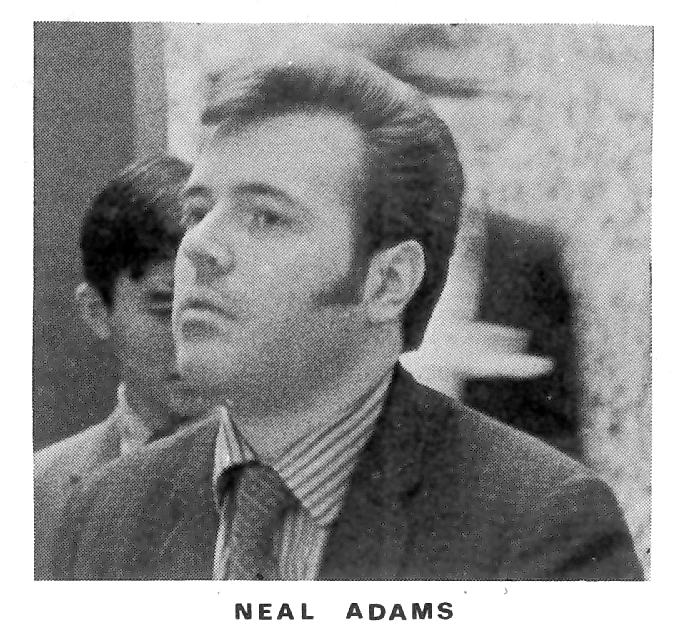 I mean, you can't pass up a photo of Neal Adams looking like Elvis! |
|
|
|
Post by tingramretro on Mar 23, 2017 11:54:43 GMT -5
Did you ever see Paul Neary's Batman spoof, The Crusader? Or Alan Moore's Daredevil satire, Dourdevil? No, I missed those. The title alone, on Dourdevil, kind of sums up the problem I had with Miller's run, brilliant as it was, and those that followed. I liked the swashbuckling, wise-cracking Daredevil, before every tragedy in the world was heaped upon him. Alan Moore shared your feelings...  It actually becomes more absurd after page one, with the arrival of Erektra, Pigseye and the Tiepin of crime, but I'd better not post the whole thing... |
|
|
|
Post by codystarbuck on Mar 23, 2017 13:37:33 GMT -5
Miracleman #2  When we last left Mike Moran, he had been reunited with former sidekick Johnny Bates. However, he quickly realizes that Bates is more than human and has, in fact, grown up in his Kid Miracleman form. He was a teenager with the power of a god and no moral compass. As an adult, he is the head of a major conglomerate; with a magnetic attraction and power resonating from him. However, he sees the threat in Mike and decides to act. As Bates floats in the air, Liz is starting to lose it, questioning why he doesn't fall. Mike tells her to run. Johnny chases after her; but, an office assistant gets in the way and gets vaporized by energy beams emitted from Johnny's eyes. He tells Miky he did that to show he wasn't squeamish about such things and to imagine what he will do to Liz. He tells Mike that he had been content to accumulate wealth and power quietly, until Miracleman returned to the scene. Then he decided to contact him to see if he was a threat and Mike saw the truth. Now all bets are off. Mike has no choice and utters, "Kimota!" and Miracleman appears and the battle begins; but, Kid Miracleman cleans his clock without breaking a sweat. johnny tells MM that he had 21 years to develop his powers, while Mike was Miracleman for only 9 years. He hadn't even begun to stretch his boundaries. A small child witnesses the fight and thinks Johnny is Superman and runs to meet him. Johnny eyes him like a cat playing with a mouse and asks the boy if he wants to fly and hurls him into the sky. Miracleman flies after and rescues the child, breaking his ribs due to impact. He returns the child to the horrified mother. Johnny goes after Liz, taunting the wounded Miracleman. He catches up with her, fleeing in a car and puts himself in its path, smashing it around his body. he confronts Liz and she is terrified.  Miracleman arrives in time; but, is still no threat to Johnny. KM is poised for the kill, when he gloats and says his own name, which includes Miracleman, his change word. Suddenly, he is nothing more than a scared little boy, crying and in shock over what has occurred. MM just picks up Liz and leaves Johnny to his fate. While the battle raged, police come on scene. reports are monitored and a call is made to a secret government department and a man named Sir Dennis Archer. He makes a call to a man named Cream. We learn that Archer headed something called the Spookshow, which in 1963 activated something called Dragonslayer and ended Project Zarathustra. Mike and Liz are next seen somewhere in the country, as Liz brings out a stack of comics and they begin testing what Miracleman can do. liz offers theories that Mike and Miracleman are two different people, sharing a mind. mike retorts that Miracleman is cleverer, purer, without human neuroses. Liz theorizes that the two bodies exist in different dimensions and switch places, noting that MM repaired his torn uniform, but his wounds hadn't totally healed, though they were rapidly doing so. She observes that the laws of physics seem bent by what MM can do, noting that a huge boulder that he hurls and lets shatter on his skull doesn't force his feet deeper into the soft earth. She notes he doesn't have the muscle development for the physical strength required and suggests that his power is all mental in nature. While this goes on, Mr Cream visits a hospital and finds one of the terrorists wounded by Miracleman, at the nuclear station. The man is burnt and deaf, so Cream writes his questions on paper, promising to spare the man for the info. The terrorist tells him about the attack and the sick journalist, which prompts a question about his appearance. Cream circles the name Moran on a list, after crossing out others. He departs by telling the terrorist that he lied about not killing him, smiling with a mouth full of ble sapphire teeth. He smothers the man and walks out. Mike and Liz leave their testing site and Liz tells mike that she has missed her period and is pregnant and Miracleman is the father. The next day, Mike is an emotional mess. he doesn't know what to think. he heads off to his job, where he learns that the paper have been hit with a D-Notice (government censorship, via the Official Secrets Act) about their MM-related story. Mike leaves the office and gets on an elvator, where a woman is having trouble with a fussy infant. she hands him to Mike to hold, while she gets his bottle out of her bag. While he holds the baby, Mr Cream, who is standing behind him, asks how he will change into Miracleman, without frying the baby and then fires several suppressed shots into Mike's body. Mike starts to lose consciousness when he wonders why the man has blue sapphire teeth? 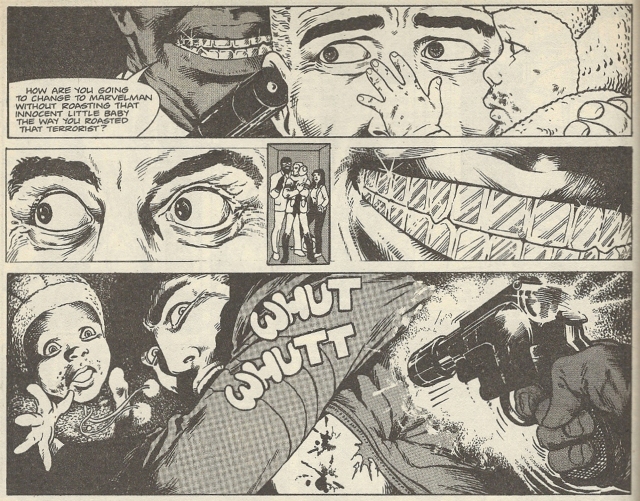 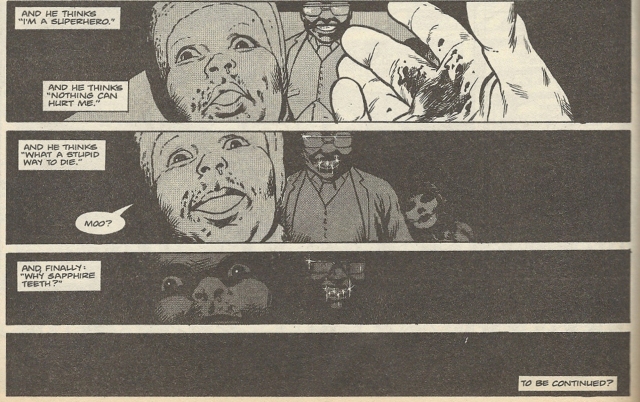 After the astonishing first issue (the US edition actually reprinted 2-3 stories from the Warrior originals, as they were shorter pieces) we see the game upped. Alan Moore has created a real villain. Johnny Bates is a twisted child trapped in an adult body; but with the power of an adult god. he has tested and grown, while Miracleman was trapped in limbo and Mike Moran grew middle-aged and soft. Miracleman is no match for him in power or experience. Bates cares nothing for human lives and will destroy anyone in his path, for expediency or just as a demonstration. The assistant's frying is horrific enough until you see him toss the child in the air. Now he is heading for Liz. We have seen him do something worse with each victim and can only dread what he will do if he catches Liz We also see that standard superhero rescues have hidden dangers, thanks to real world physics, as the child, who is traveling at great speed, impacts with Miracleman's invulnerable arms. he is as gentle as he can be, but still breaks the child's ribs. Johnny is only stopped by chance, with a dark twist on the old Captain Marvel gag of tricking Black Adam into saying "Shazam!" We then see the real boy, who has been trapped for 21 years. Moore tantalizes us with more of the mysterious past of Miracleman and Johnny, as we see it is related to a secret Air Force intelligence department and project. We get a flashback to a weapon detonating, mirroring Mike's dreams of alien ships and nuclear explosions. This Sir Dennis Archer holds the key to Miracleman's past and he has dispatched Evelyn Cream, (male, as in Evelyn Waugh) to tie up loose ends and track down the mysterious figures. Cream is a deadly and clever hunter, as he is able to shoot Mike, by contriving his holding an innocent child and planting the suggestion that if he changes, he will vaporize the child. This is a horror title, not a superhero book. Gary Leach's tenure ends and Alan Davis begins, between chapters 5 and 6. Davis brings more of a superhero look to things, though Leach inks him, keeping things consistent. By Chapter 7 (I think) Davis is on his own. He continues the realistic look of things, while adding his own sinister touches, via Evelyn Cream, the dead body of the terrorist, the facial expressions. There is a looming sense of dread, visually, as chapter 8 moves from the emotional mess that is now Mike and Liz's life and Cream confronting Mike on the elevator and shooting him. One of the brilliant elements of this series is Moore's use of psychology, tapping into real fears of humans and how people might react to comic book situations, if they encountered them in the real world. Gods fighting is seens as a holocaust and people are terrified even of the "hero." Mike is all twisted inside as he tries to cope with his lost past, Johnny's psychotic growth, his growing understanding of his true power and the danger of it, and Liz's pregnancy, by the god. This was so beyond everything in comics, at the time and has been strip-mined by lesser writers ever since. Consider if Dr Manhattan had come up against someone who could do everything he could and more, while trying to hold onto his human identity. This is deconstruction on a more psychological and philosophical level. Even with only two issues in, we get the sense that this will not have a happy ending. |
|
|
|
Post by Spike-X on Mar 24, 2017 6:07:16 GMT -5
Did you ever see Paul Neary's Batman spoof, The Crusader? Or Alan Moore's Daredevil satire, Dourdevil? No, I missed those. The title alone, on Dourdevil, kind of sums up the problem I had with Miller's run, brilliant as it was, and those that followed. I liked the swashbuckling, wise-cracking Daredevil, before every tragedy in the world was heaped upon him. Mark Waid's recently-completed run was a breath of fresh air. It had its serious moments, but wasn't afraid to show DD having fun, and even smiling from time to time. As much as I loved the Bendis and Brubaker stories, sometimes they made me want to take a nice, long bath with a razor blade. |
|
|
|
Post by codystarbuck on Mar 24, 2017 22:03:23 GMT -5
Miracleman #3  I love Howard Chaykin; but, I never thought the character looked right, on that cover. Still better than the cover for #8, though. The pacing of the first chapter is exquisite! Alans Moore & Davis jump back and forth between scenes of Miracleman advancing upon a location, with men and weapons attacking him and his complete lack of acknowledgement of any threat, and scenes of Evelyn Cream filling Mike Moran in with background detail about Project Zarathustra. Sandwiched in between is a running conversation between Sir Dennis Archer, head of the Spookshow, and contemporaries, filling in some of the gaps. 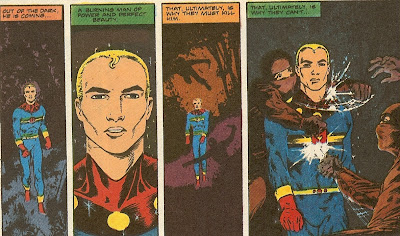 Miracleman advances forward and doesn't react to balaclava-masked men attacking him from the shadows. They fall with their hands smoking. Back in time, Mike Moran wakes up and Evelyn Cream tells him he shot him with tranquilizer bullets. Mike is gagged, so he can't trigger the change to Miracleman. Cream tells him that he received his powers in 1954, under project Zarathustra, which was run by the Spookshow. In 1963, the Spookshow decided to close down the experiment and used an A-bomb to try to destroy the three subjects. It failed. Miracleman reappeared in 1982 and Cream was dispatched to learn his identity. However, he has double-crossed his employers.  Flame throwers and rocket launchers do not stop Miracleman and soldiers burn instead. Miracleman continues to advance. In the past, Cream strikes a bargain with Mike, to lead him to the Project Zarathustra bunker (and answers to his past) and releases him. Mike says "Kimota!" and transforms and Cream is impressed. Miracleman shreds fencing and men and Sir Dennis tells us a large bomb was planted, as the next line of defense. It detonates and Miracleman advances. Sir Dennis speaks of why Zarathustra wasn't burned to the ground. The creator of the project disappeared with his files; but, there had been advancements and Sir Dennis wanted to recoup some of the massive budget. There were other experiments. Miracleman comes face to face with one. 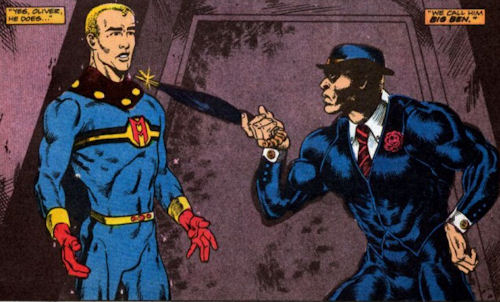 Evelyn Cream follows Miracleman's trail, littered with the dead bodies of soldiers and signs of destruction. Miracleman is attacked by the agent code named: Big Ben, The Man with No Time for Crime! He has been dispatched by Sir Dennis Archer and believes Miracleman is a Soviet Agent, Major Molotov. Big Ben fought alongside Doc Thunderbolt, against Menace. he defeated a string of villains. He hits Miracleman with a boulder and Miracleman just stairs at him. he uproots a tree and smashes it into an indifferent Miracleman. MM eyes Big Ben and thinks the whole thing is absurd. BB isn't as powerful and he thinks his mind is damaged. The bowler hat and umbrella are straight out of a comic book. he finally loses patience and just swats Big ben away, who eventually comes crashing down near Evelyn Cream. Cream catches up and they reach the bunker doors. Cream, sets explosives to blow the door and Miracleman takes care of it.  Inside, Miracleman sees the remains of the project that spawned him...  Inside are skeletons. One is marked Young Miracleman and features two skeletons fused together. there is another skeleton that is obviously not human, or like anything else on the planet. There are computer banks and monitor screens, some more akin to a sci-fi movie. Cream is able to activate the record files on the monitor and Miracleman watches as his past unfurls. Alien technology and an alien's corpse gave the Spookshow the means to create a clone. They genetically engineered it to unleash the untapped potential in mankind. However, the clone doesn't have an independent consciousness. It is tied to a human subject. Trigger implants are inserted in both human and clone brains, then one is dispatched to "Infra-space" where it is able to co-exist, without being on the same plane. A post-hypnotic trigger command activates the switch and the bodies trade place. The tapes skip ahead and we see the subjects being tested. Their human hosts were all orphans of Air Force personnel. The tapes skip further ahead. Other experiments were tried, but without the genius behind the creation of the project. The result was Big ben, who is impressive, though vastly inferior to Miracleman and the para-reality processing has left him with a damaged mid. Unknown to Miracleman and Cream, BB is awake and has come inside the bunker and see s the data about himself. Checking further back, Miracleman sees how his body was subjected to virtual reality scenarios, inspired by comic book stories. We see some of the fantasy adventures and learn how MM was programmed to believe they were his life. Miracleman grows agitated and then hears a familiar voice and sees the face of Dr Emil Gargunza, who speaks of the programming and the scenarios derived from comic books. MM explodes and smashes equipment in a rage and leaves the bunker with Cream. Big Ben is left behind, nearly catatonic as his brain can't deal with the reality. Two Spookshow operatives arrive and take him away in a straight-jacket, though he sees them as Jack Ketch and Owl Woman, who use a Hyper-Vest, to drain away the mind-clouding radiation that is feeding him the false images. So much stuff here. We see just how powerful MM is, as he proves impervious to knives, bullets, explosives, fire, and everything short of a nuclear weapon. Sir Dennis reminds us that he survived a nuclear explosion, in 1963. He shows no regard for the soldiers and brushes them away like ants. Big Ben adds some black comedy, as he acts like a typical superhero, as written in the 50s. He is not enough to even slow Miracleman. The project is astounding and we see how alien technology made the creation of this fantastic being possible. There had to be a genius at the center and we are teased with that until we see the image of Dr Gargunza, who Miracleman believes was his enemy, due to the para-reality programming (more on that in coming issues). Moore moves this along like a train heading for a cliff, gaining speed along the way. The conversations from Cream and Sir Dennis, and Spookshow reports act like color commentary in a sporting event. Moore strips away fantasy and gives us a twisted reality. The Air Force found alien remains and technology and experimented on orphaned children, as no one could object to their disappearance. The project created weapons that could outdo every other weapon on the planet; but, could they control them? Apparently, they thought not and used a nuke to destroy them. It didn't work. Imagine what that means when Miracleman is no longer distracted by learning his past? That is what we can anticipate, for the future. Alan Davis is in full bloom here, cutting between scenes of silhouetted desperate and argumentative men. He has only body language to tell their story, matching Moore's words. The scenes of Cream and Mike show a scared and hurt Mike who is slowly realizing what Cream is telling him, juxtaposed by the delight in Cream's face, yet his straight-forward, logical delivery of background facts. The path of destruction up to the bunker is chilling, as Davis keeps an impassive look on Miracleman's face, while soldiers attack and are brushed off. The fight with Big Ben is straight out of a comic book textbook, except MM doesn't react. the, he just swings his hand and knocks him away, like a gnat. He draws anger on MM's face, as he views the tapes and pure rage, when Gargunza comes on screen. Big Ben is drawn as massively bruised and his eyes are wide, yet you see the emptiness behind them. You can see that he can't deal with reality. Gargunza looms in the video monitor like some kind of haunted house figure. 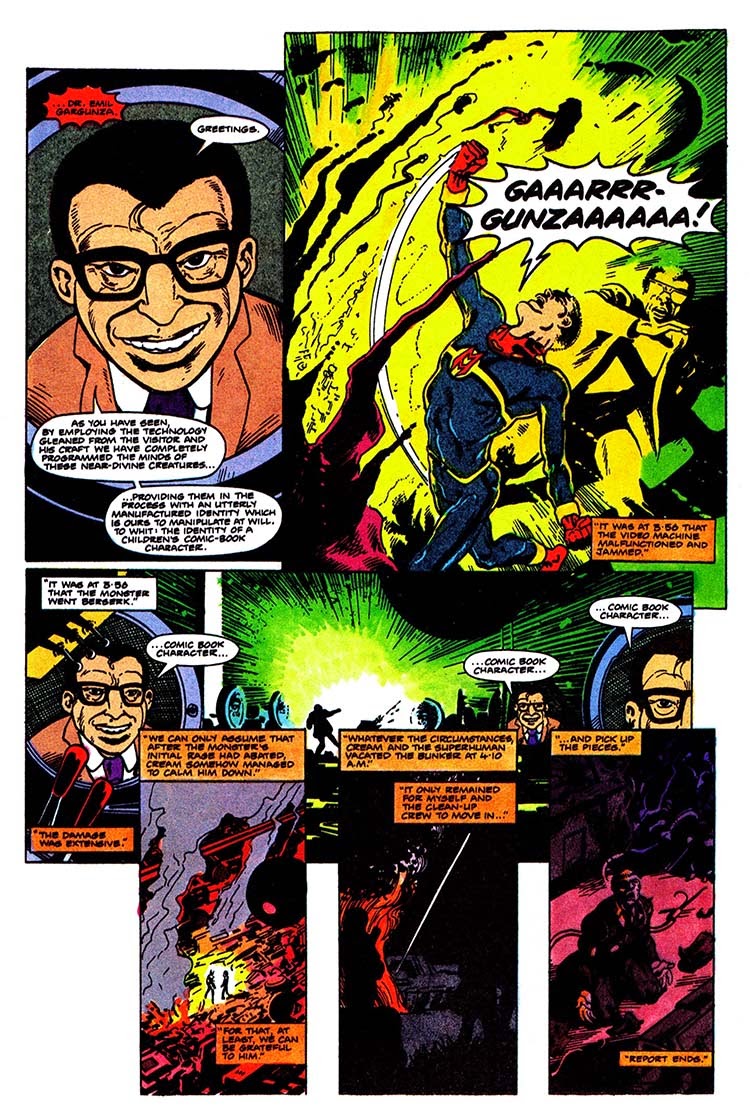 This issue is just amazing. the writing is so far above what was being done in comics and still stands above most created since. The art is in perfect sync with the words. Miracleman and Mike Moran's reality has come crashing down and we know a reckoning is coming. |
|
|
|
Post by codystarbuck on Mar 24, 2017 22:22:17 GMT -5
Just a side bar on Big ben, The Man With No Time for Crime! The character appeared in the Warrior Summer Special (which is the 4th issue of Warrior).  He's pretty much a superhero version of John Steed, of the tv show, The Avengers. he has the same umbrella and Bowler hat that became synonymous with Steed. he operates out of a secret lair within the actual Big Ben clock, in Elizabeth Tower, at Westminster (aka The Houses of Parliament). He was created by Dez Skinn who wrote his adventures in Warrior, before handing him over to a young Grant Morrison. There, the reality is different than in Marvelman. 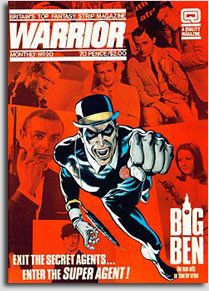 The stories that were published were delightfully tongue-in-cheek and one even spoofs The Prisoner. |
|
































